Contrastive Analysis of Deep-Water Sedimentary Architectures in Central West African Passive Margin Basins During Late-Stage Continental Drift
Abstract
1. Introduction
2. Regional Geological Overview
2.1. Tectonic Evolution and Basin Structure
2.2. Stratigraphic Framework and Sedimentary Characteristics
3. Datasets and Methods
4. Results
4.1. Deep-Water Sedimentary Systems Description
4.1.1. Lithofacies Types
4.1.2. Major Architectural Unit Characteristics
Deep-Water Channel-Levee Complexes
Fan Lobes
4.2. Comparison of Shelf-Margin Structures and Sedimentary Architectures
5. Discussion: Controlling Factors for Sedimentary Heterogeneity
5.1. Regional Tectonic Setting
5.2. Oceanographic Controls
5.2.1. Global Sea Level Changes
5.2.2. Paleodrainage Stability
5.3. Pre-Depositional Substrate Geometry
5.3.1. Paleouplift
5.3.2. Shale and Salt Diapirism
5.4. Shelf-Slope Geometry
5.5. Impact on Oil and Gas Exploration
6. Conclusions
- (1)
- Since the Eocene, the Lower Congo Basin has mainly formed a narrow shelf-steep slope retrogradational deep-water turbidite sand system, showing that the basin fan bodies have changed from multi-source small to single-source large, single-step deposition, mainly developing deep-water turbidite/erosion channels, levees, large-scale terminal lobes, and deep-sea mud, controlled by margin uplift tilting and the degree of salt tectonic activity, gradually transitioning from salt diapirs to salt walls from land to sea, resulting in channel flow changes or lobe formation.
- (2)
- In the late stage of continental drift, the Niger Delta Basin is mainly a wide shelf-gentle slope large-scale progradational delta and its distal sand system, multi-point source supply, multi-step development, mainly depositing delta front underwater distributary channels, prodelta-semi-deep-sea mud, and medium-to-small-scale submarine fan lobes and small-scale slope fan lobes dominated by sedimentary channel-fan lobes, controlled by gravity-driven systems with mud structures as detachment surfaces, and mound-shaped mud diapirs form local uplifts.
- (3)
- A comparison of the shelf-edge structure styles and sedimentary architectural characteristics in the late stage of continental drift shows that the Lower Congo Basin is in a condition of low sediment supply, medium-to-low equal accommodation space, and icehouse climate, mainly developing by-pass type and single (multi)-period confined deep-water channel-natural levee systems; while the Niger Delta Basin belongs to a high sediment supply, medium accommodation space, and icehouse environment, mainly composed of various lobe systems such as retro(pro)gradational and single (double)-directional swing types.
- (4)
- Deltaic sedimentation can be regarded as a turbidite sedimentary system less affected by upwelling. Due to the constraints of various factors such as tectonic background, sea level changes, paleo-geomorphology, mud/salt diapirism, and shelf-slope types, there are differences in shelf-edge structure styles and sedimentary configurations between the two types of passive margin basins. Among them, regional or local tectonic activity is the main factor controlling deep-water turbidite sedimentation in the late stage of continental drift in the two basins, and sea level changes also affect the development of deep-water systems to a certain extent, while the differences in shelf-slope types and basin floor paleohighs are specific manifestations of the former two in the deep-water sedimentation process.
Author Contributions
Funding
Data Availability Statement
Acknowledgments
Conflicts of Interest
References
- Reading, H.G.; Richards, M. Turbidite systems in deep-water basin margins classified by grain size and feeder system. AAPG Bull. 1994, 78, 792–822. [Google Scholar] [CrossRef]
- Marcano, G.; Anka, Z.; di Primio, R. Major controlling factors on hydrocarbon generation and leakage in South Atlantic conjugate margins: A comparative study of Colorado, Orange, Campos and Lower Congo basins. Tectonophysics 2013, 60, 172–190. [Google Scholar] [CrossRef]
- Gong, C.; Steel, R.J.; Wang, Y.; Lin, C.; Olariu, C. Shelf-margin architecture variability and its role in sediment-budget partitioning into deep-water areas. Earth-Sci. Rev. 2016, 154, 72–101. [Google Scholar] [CrossRef]
- Zhang, J.J.; Wu, S.; Hu, G.; Fan, T.-E.; Yu, B.; Lin, P.; Jiang, S. Sea-level control on the submarine fan architecture in a deepwater sequence of the Niger Delta Basin. Mar. Pet. Geol. 2018, 94, 179–197. [Google Scholar] [CrossRef]
- Wang, L.L.; Wang, Z.Q.; Xiao, P. Characterization of deep water sedimentary system in the Miocene of Block A in Lower Congo Basin. Oil Gas Geol. 2015, 36, 963–974. [Google Scholar]
- Zhao, P.F.; Zhang, H.; Bu, F.; Wu, J.; Yang, X. The sedimentary architecture characteristics and fluid system of the deep sea turbidite-lobe complex sandbodies: A case study of the deep-water region in the Niger Delta Front. Earth Sci. 2017, 42, 1972–1983. [Google Scholar]
- Li, Q.; Wu, W.; Kang, H.Q.; Ren, S.J.; Pang, L.A.; Yang, T.; Cai, L.L.; Liu, X.L. Characteristics and controlling factors of deep-water channel sedimentation in Lower Congo Basin, West Africa. Oil Gas Geol. 2019, 40, 917–929. [Google Scholar]
- Weimer, P.; Slatt, R.M. Introduction to the Petroleum Geology of Deepwater Settings; AAPG/Datapages: Tulsa, OK, USA, 2007. [Google Scholar]
- Qin, Y.Q.; Ba, D.; Xu, H.L.; Liang, Y.B.; Yang, Z.; Liang, X.; Wang, X.L. Sedimentation and hydrocarbon accumulation of deep-water fan fed by large canyon in passive continental margin: A case of Congo fan in West Africa. China Pet. Explor. 2018, 23, 59–68. [Google Scholar]
- Posamentier, H.; Walker, R. Deep-Water Turbidites and Submarine Fans; SEPM Special Publication: Tulsa, OK, USA, 2006; pp. 399–520. [Google Scholar]
- Hüneke, H.; Mulder, T. Deep-Sea Sediments; Elsevier: Amsterdam, The Netherlands, 2011. [Google Scholar]
- Liu, X.Y. Depositional characteristics and evolution of the Tertiary deep-water fan in West Africa. J. Northeast. Pet. Univ. 2013, 37, 24–31. [Google Scholar]
- Wang, W.G.; Tong, X.G.; Zhang, Y.X.; Cheng, K.N. Features of major passive continental margin basins, South Atlantic Ocean. China Pet. Explor. 2012, 17, 62–69. [Google Scholar]
- Estrella, G. Breaking paradigms giant and super-giant discoveries in Brazil. In Proceedings of the AAPG Annual Conventional and Exhibition, Denver, CO, USA, 7–10 June 2009. [Google Scholar]
- Qin, Y.Q.; Zhang, G.Y.; Liang, Y.B.; Wen, Z.X.; Wang, Z.M.; Zhang, L.; Ba, D.; Wang, Y.H. Distribution characteristics, accumulation rules and exploration directions of deep water hydrocarbon in South Atlantic. Nat. Gas Geosci. 2016, 27, 229–240. [Google Scholar]
- IHS. International Energy Oil & Gas Industry Solutions; IHS: Rockville, MD, USA, 2014. [Google Scholar]
- Feng, Y.W.; Qu, H.J.; Zhang, G.C.; Mi, L.J.; Fan, Y.H.; Guan, L.Q. Toctonic-Sedimentary Evolution and its Control on Source-Reservior-Cap Rocks in Passive Continental Margin, West Africa. Mar. Orig. Pet. Geol. 2010, 15, 45–51. [Google Scholar]
- Luo, Y.; Li, J.H.; Yang, M.L. A comparative study of tectonic and sedimentary evolution of West African coastal basins in the south Atlantic Ocean region. Geol. China 2021, 48, 120–128. [Google Scholar]
- Anka, Z.; Séranne, M.; Lopez, M.; Scheck-Wenderoth, M.; Savoye, B. The long-term evolution of the Congo deep-sea fan: A basin-wide view of the interaction between a giant submarine fan and a mature passive margin (ZaiAngo project). Tectonophysics 2009, 470, 42–56. [Google Scholar] [CrossRef]
- Deng, R.J.; Deng, Y.H.; Yu, S.; Hou, D.J. Hydrocarbon geology and reservoir formation characteristics of Niger Delta Basin. Pet. Explor. Dev. 2008, 35, 755–762. [Google Scholar]
- Navarre, J.-C.; Claude, D.; Liberelle, E.; Safa, P.; Vallon, G.; Keskes, N. Deepwater turbidite system analysis, West Africa: Sedimentary model and implications for reservoir model construction. Lead. Edge 2002, 21, 1132–1139. [Google Scholar] [CrossRef]
- Cai, L.L.; Wang, Y.; Wang, Y.; Dong, S.; Zhu, S.; Liao, J.; Zhao, Z.; Xue, D. Type features and hydrocarbon exploration significance of deepwater sedimentary in West Africa. Acta Pet. Sin. 2016, 37, 131–142. [Google Scholar]
- Liu, X.Y.; Yu, S.; Tao, W.X.; Hu, X.L.; Hao, L.H. Filling architecture and evolution of Upper Miocene deep-water channel in Congo Fan Basin. Earth Sci. 2012, 37, 105–112. [Google Scholar]
- Hooper, R.J.; Fitzsimmons, R.J.; Grant, N.; Vendeville, B.C. The role of deformation in controlling depositional patterns in the south-central Niger Delta, West Africa. J. Struct. Geol. 2002, 24, 847–859. [Google Scholar] [CrossRef]
- Shi, S.Y.; Yu, Y.X.; Yin, J.Y.; Wu, C.W.; Liu, J.J.; Liu, Y.L.; Wang, B. Deformation characteristics and formation mechanisms of salt structures in the Lower Congo Basin. Oil Gas Geol. 2020, 41, 1092–1099. [Google Scholar]
- Feng, Z.Q.; Guo, F.T.; Zhang, Z.M.; Yin, J.Y.; Tian, N.X.; Su, Y.S.; Guo, R.T.; Wu, G.K. A transform margin: Review of genetic types of the Niger Delta Basin. Acta Petrol. Sin. 2022, 38, 2565–2580. [Google Scholar]
- Cai, L.L.; Xie, X.J.; Li, J.P.; Liao, J.H. Influence of different modes of deep-water sedimentation on oil and gas distribution: A case study of deep-water fans in eastern and western Niger Delta Basin. Acta Sedimentol. Sin. 2022, 40, 229–243. [Google Scholar]
- Partyka, G.; Gridley, J.; Lopez, J. Interpretational applications of spectral decomposition in reservoir characterization. Lead. Edge 1999, 18, 353–360. [Google Scholar] [CrossRef]
- Pigott, J.D.; Abdel-Fattah, M. Seismic stratigraphy and geomorphology of offshore Tanzania. Interpretation 2014, 2, 1–13. [Google Scholar]
- Catuneanu, O.; Galloway, W.E.; Kendall, C.G.; Miall, A.D.; Posamentier, H.W.; Strasser, A.; Tucker, M.E. Sequence stratigraphy: Methodology and nomenclature. Newsl. Stratigr. 2011, 44, 173–245. [Google Scholar] [CrossRef]
- Allen, P.A.; Armitage, J.J.; Carter, A.; Duller, R.A.; Michael, N.A.; Sinclair, H.D.; Whitchurch, A.L.; Whittaker, A.C. The Qs problem: Sediment volumetric balance of proximal foreland basin systems. Sedimentology 2013, 60, 102–130. [Google Scholar] [CrossRef]
- Jermannaud, P.; Rouby, D.; Robin, C.; Nalpas, T.; Guillocheau, F.; Raillard, S. Plio-Pleistocene sequence stratigraphic architecture of the eastern Niger Delta: A record of eustasy and aridification of Africa. Mar. Pet. Geol. 2010, 27, 810–821. [Google Scholar] [CrossRef]
- Armitage, D.A.; McHargue, T.; Fildani, A.; Graham, S.A. Postavulsion channel evolution: Niger Delta continental slope. AAPG Bull. 2012, 96, 823–843. [Google Scholar] [CrossRef]
- Wang, L.L.; Wang, Z.Q.; Yu, S.N.N.R. Seismic responses and controlling factors of Miocene deepwater gravity-flow deposits in Block A, Lower Congo Basin. J. Afr. Earth Sci. 2016, 120, 31–43. [Google Scholar] [CrossRef]
- Schwab, A.M.; Cronin, B.T.; Ferreira, H. Seismic expression of channel outcrops: Offset stacked versus amalgamated channel systems. Mar. Pet. Geol. 2007, 24, 504–514. [Google Scholar] [CrossRef]
- Mayall, M.; Jones, E.; Casey, M. Turbidite channel reservoirs—Key elements in facies prediction and effective development. Mar. Pet. Geol. 2006, 23, 821–841. [Google Scholar] [CrossRef]
- Posamentier, H.W.; Kolla, V. Seismic geomorphology and stratigraphy of depositional elements in deep-water settings. J. Sediment. Res. 2003, 73, 367–388. [Google Scholar] [CrossRef]
- Wang, W.W.; Wang, D.; Sun, J.; Shao, D.; Lu, Y.; Chen, Y.; Wu, S. Evolution of deepwater turbidite bedforms in the Huaguang channel–lobe transition zone revealed by 3D seismic data in the Qiongdongnan Basin, South China Sea. Geomorphology 2020, 370, 107412. [Google Scholar] [CrossRef]
- Guo, X.; Liu, X.; Zheng, T.; Zhang, H.; Lu, Y.; Li, T. A mass transfer-based LES modelling methodology for analyzing the movement of submarine sediment flows with extensive shear behavior. Coast. Eng. 2024, 191, 104531. [Google Scholar] [CrossRef]
- Prélat, A.; Hodgson, D.M.; Flint, S.S. Evolution, architecture and hierarchy of distributary deep-water deposits: A high-resolution outcrop investigation from the Permian Karoo Basin, South Africa. Sedimentology 2009, 56, 2132–2154. [Google Scholar] [CrossRef]
- Picot, M.; Droz, L.; Marsset, T.; Dennielou, B.; Bez, M. Controls on turbidite sedimentation: Insights from a quantitative approach of submarine channel and lobe architecture (Late Quaternary Congo Fan). Mar. Pet. Geol. 2016, 72, 423–446. [Google Scholar] [CrossRef]
- Yu, X.; Hou, G.T.; Dai, S.H.; Han, Y.C.; Xie, J.L. Comparison of petroleum geology characteristics and hydrocarbon accumulation regularity of deep water basins in eastern part of Brazil. Mar. Orig. Pet. Geol. 2016, 21, 61–72. [Google Scholar]
- Leturmy, P.; Lucazeau, F.; Brigaud, F. Dynamic interactions between the Gulf of Guinea passive margin and the Congo River drainage basin: Morphology and mass balance. J. Geophys. Res. 2003, 108, 1–19. [Google Scholar] [CrossRef]
- Séranne, M.; Anka, Z. South Atlantic continental margins of Africa: A comparison of the tectonic vs climate interplay on the evolution of equatorial west Africa and SW Africa margins. J. Afr. Earth Sci. 2005, 43, 283–300. [Google Scholar] [CrossRef]
- Reijers, T.J.A. Stratigraphy and sedimentology of the Niger Delta. Geologos 2011, 17, 133–162. [Google Scholar] [CrossRef]
- Vail, P.R.; Mitchum, R.M., Jr. Global Cycles of Relative Changes of Sea Level from Seismic Stratigraphy1. In Geological and Geophysical Investigations of Continental Margins; Watkins, J.S., Montadert, L., Dickerson, P.W., Eds.; American Association of Petroleum Geologists: Tulsa, OK, USA, 1979. [Google Scholar]
- Hong, F.H. Comparison on Deep Water Deposition of West Africa Passive Margin Basins: Case Studies of Niger Delta Basin and Lower Congo Basin; China University of Petroleum (Beijing): Beijing, China, 2016. [Google Scholar]
- Gong, L.; Gao, X.Z.; Qu, F.T.; Zhang, Y.S.; Zhang, G.Y.; Zhu, J. Reservoir quality and controlling mechanism of the Upper Paleogene fine-grained sandstones in lacustrine basin in the hinterlands of northern Qaidam Basin, NW China. J. Earth Sci. 2023, 34, 806–823. [Google Scholar] [CrossRef]
- Jackson, M.P.A.; Hudec, M.R. Salt Tectonics: Principles and Practice; Cambridge University Press: Cambridge, UK, 2017. [Google Scholar]
- Wang, D.J.; Li, J.H.; Cheng, P.; Li, Y.H.; Liu, Z.Q.; Wang, Y. Controlling factors of salt tectonic formation in the South Atlantic passive margin basins. Geotecton. Metallog. 2019, 43, 924–933. [Google Scholar]
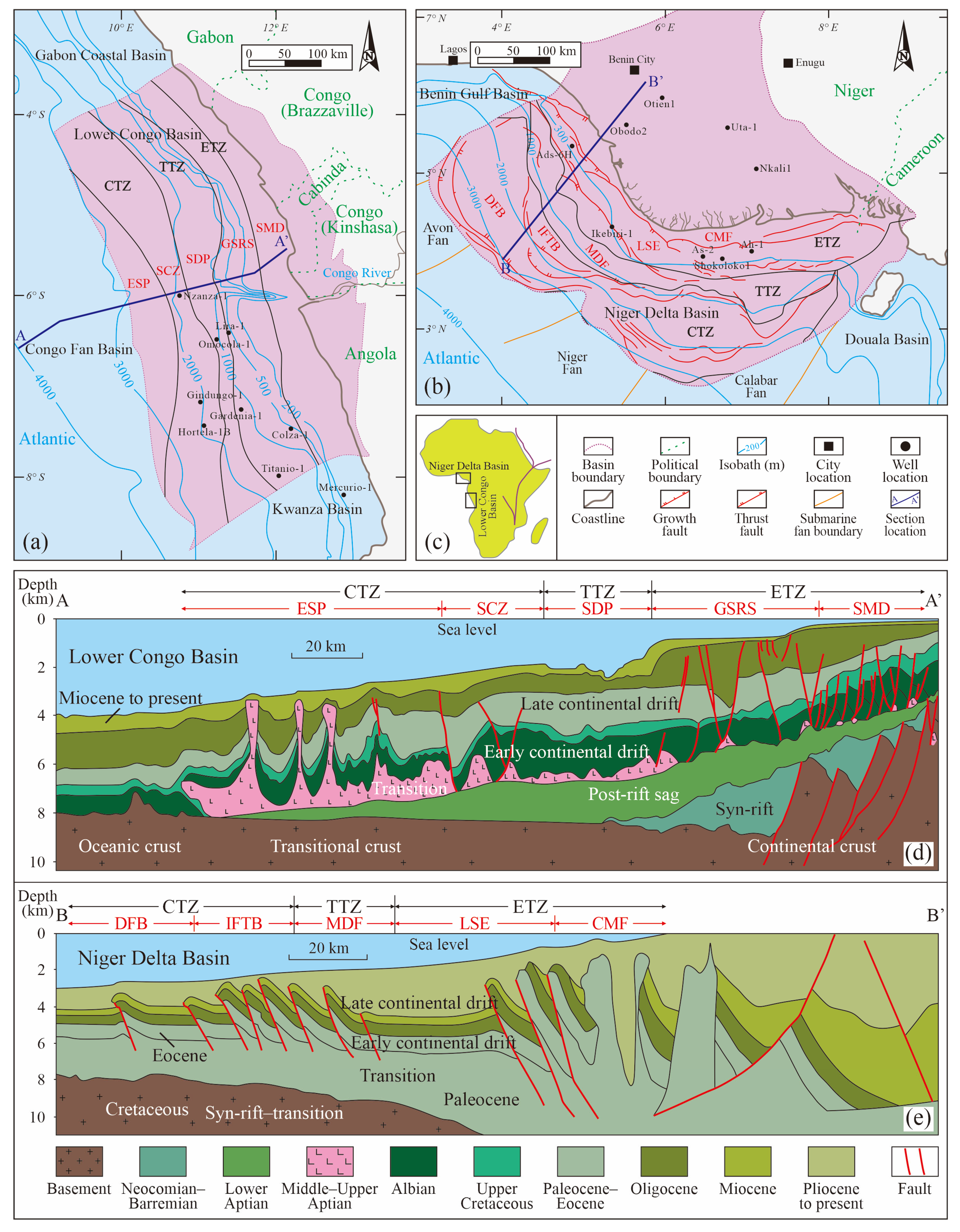
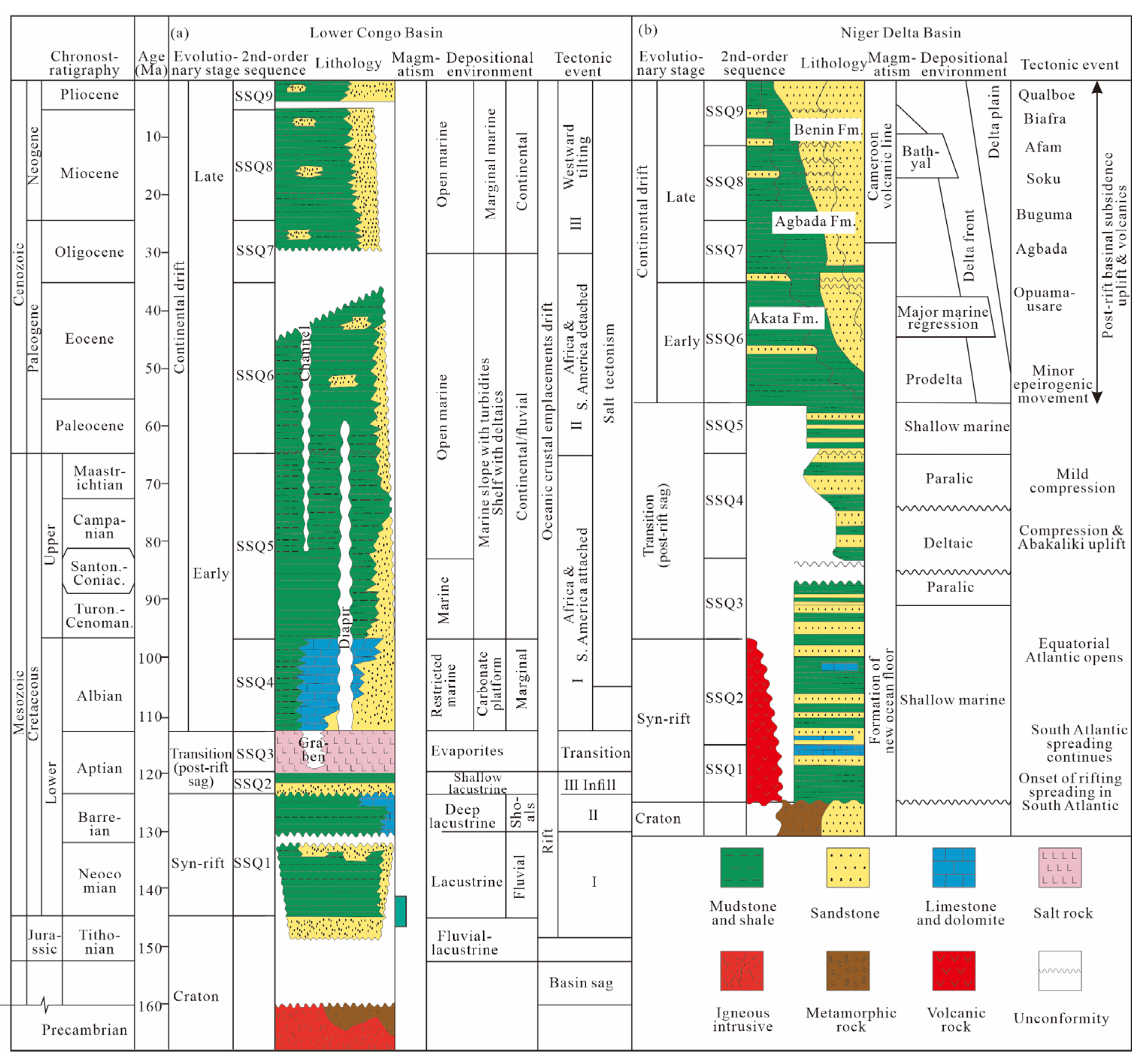
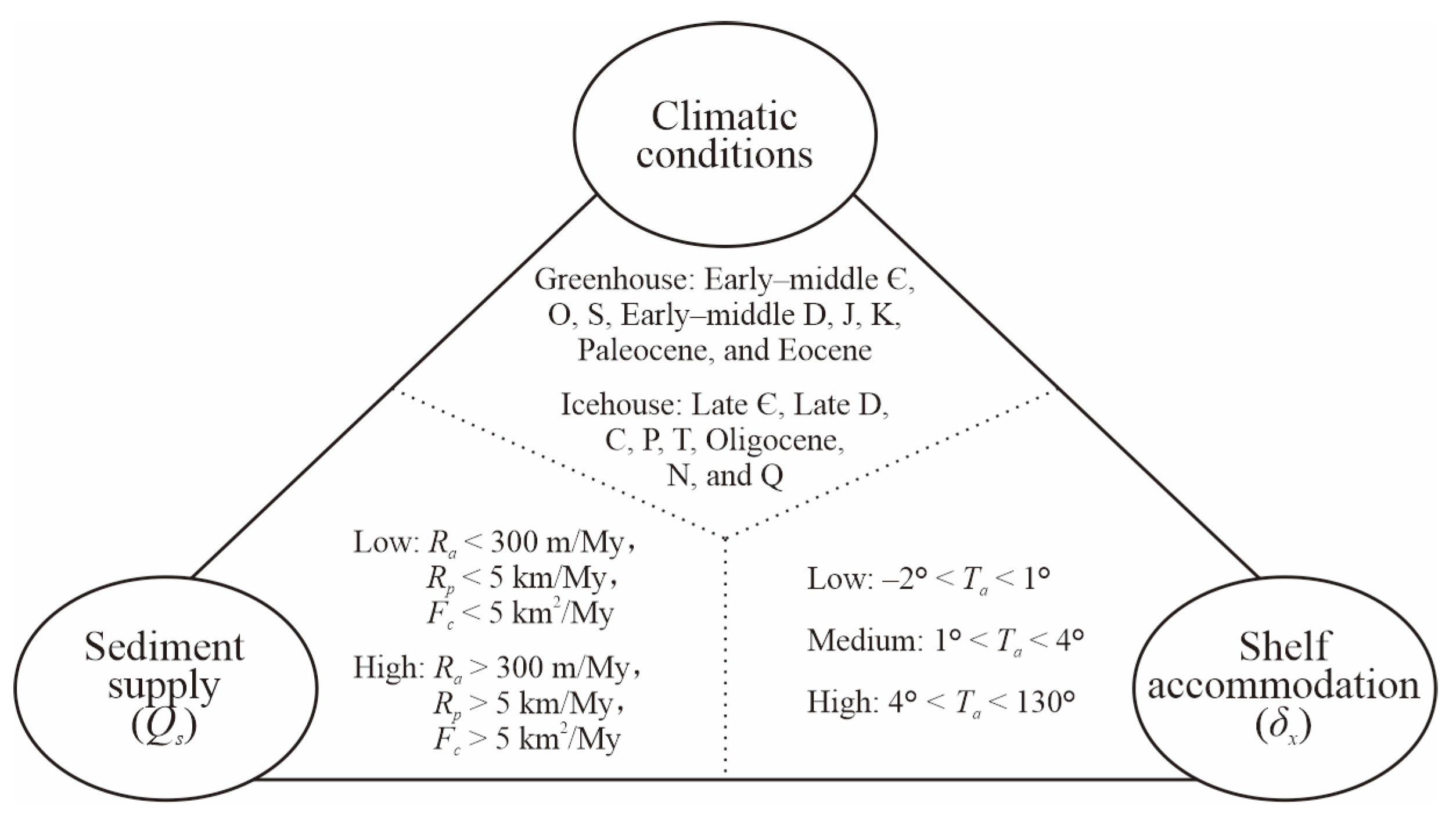
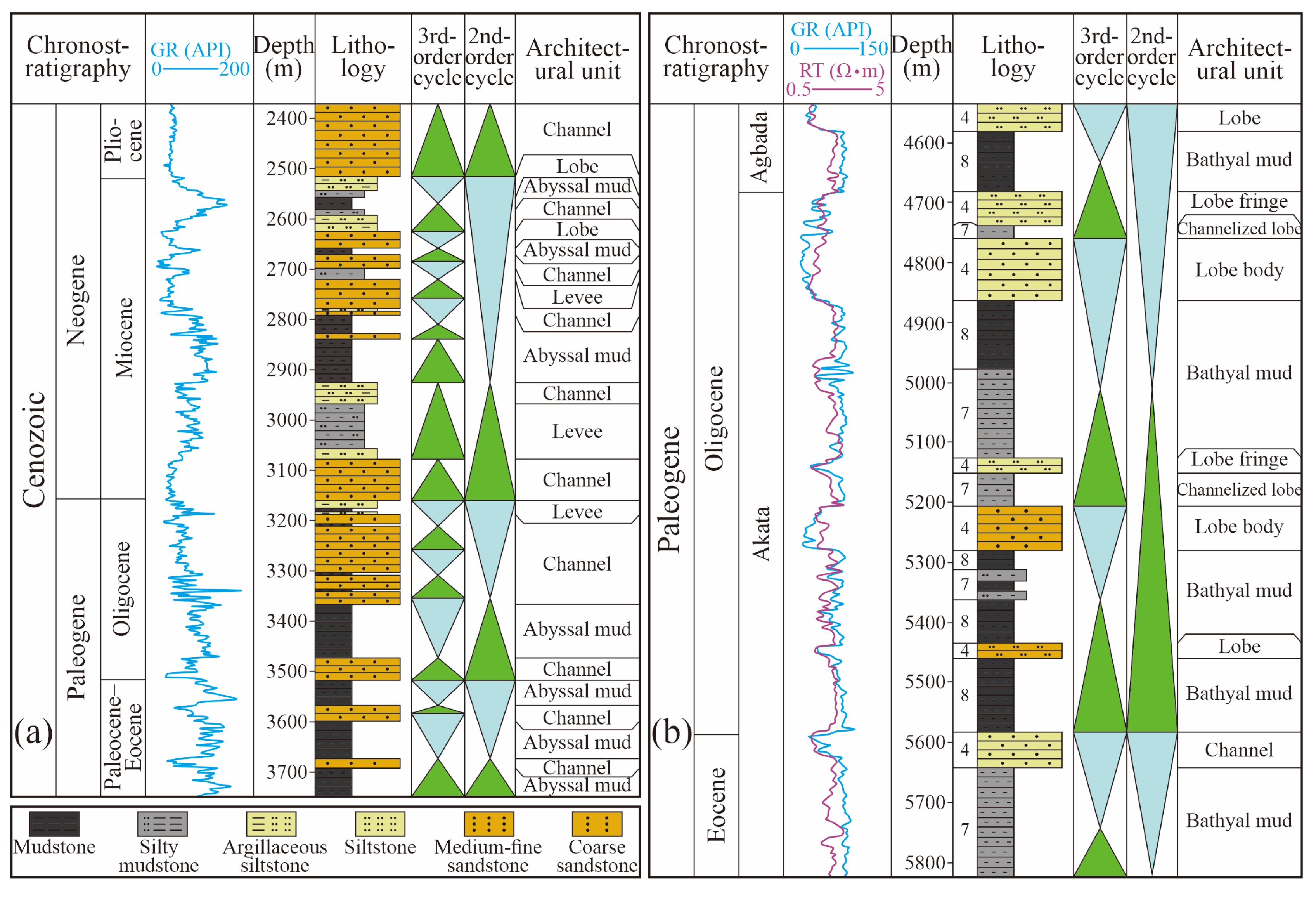
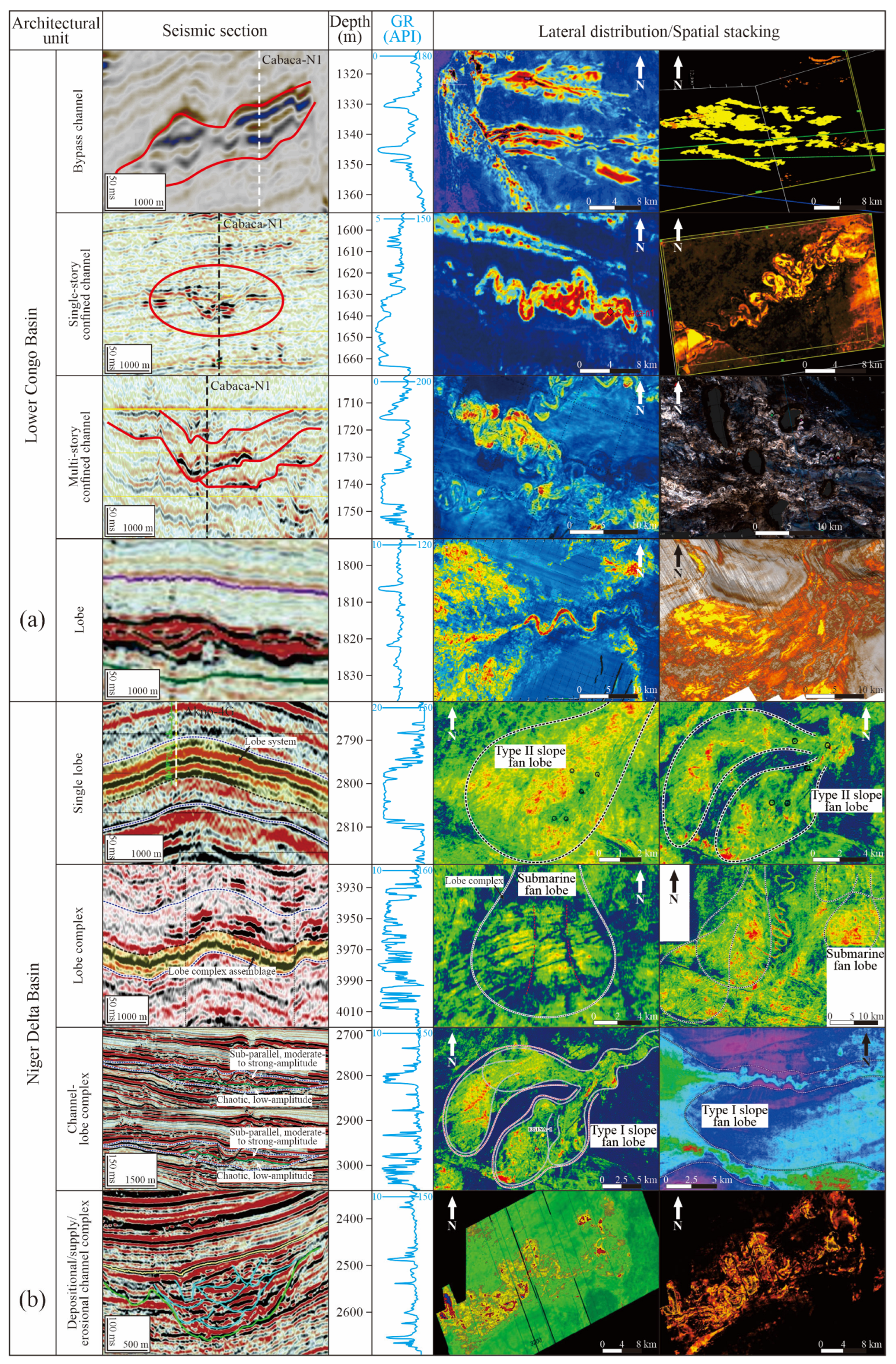



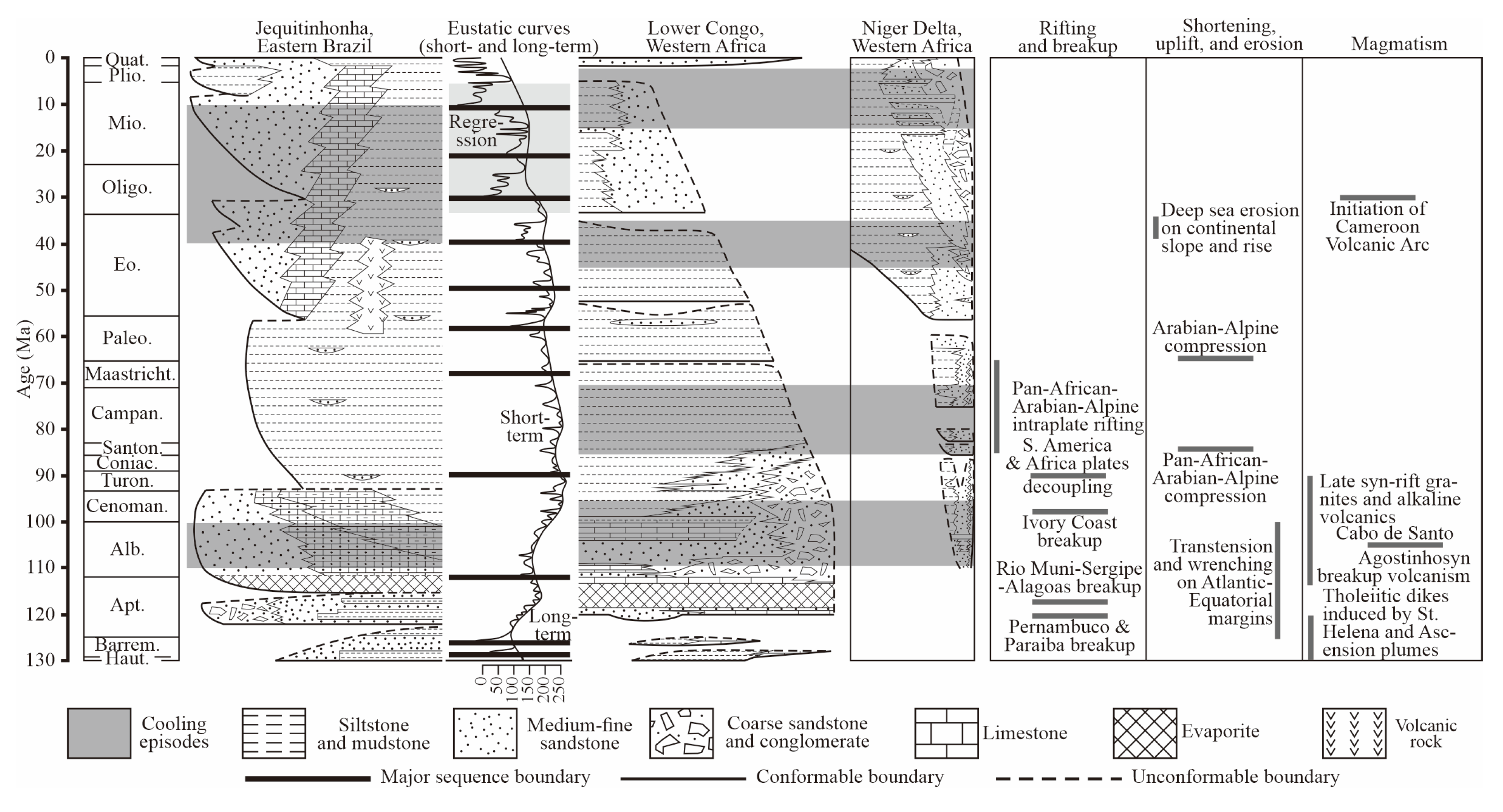
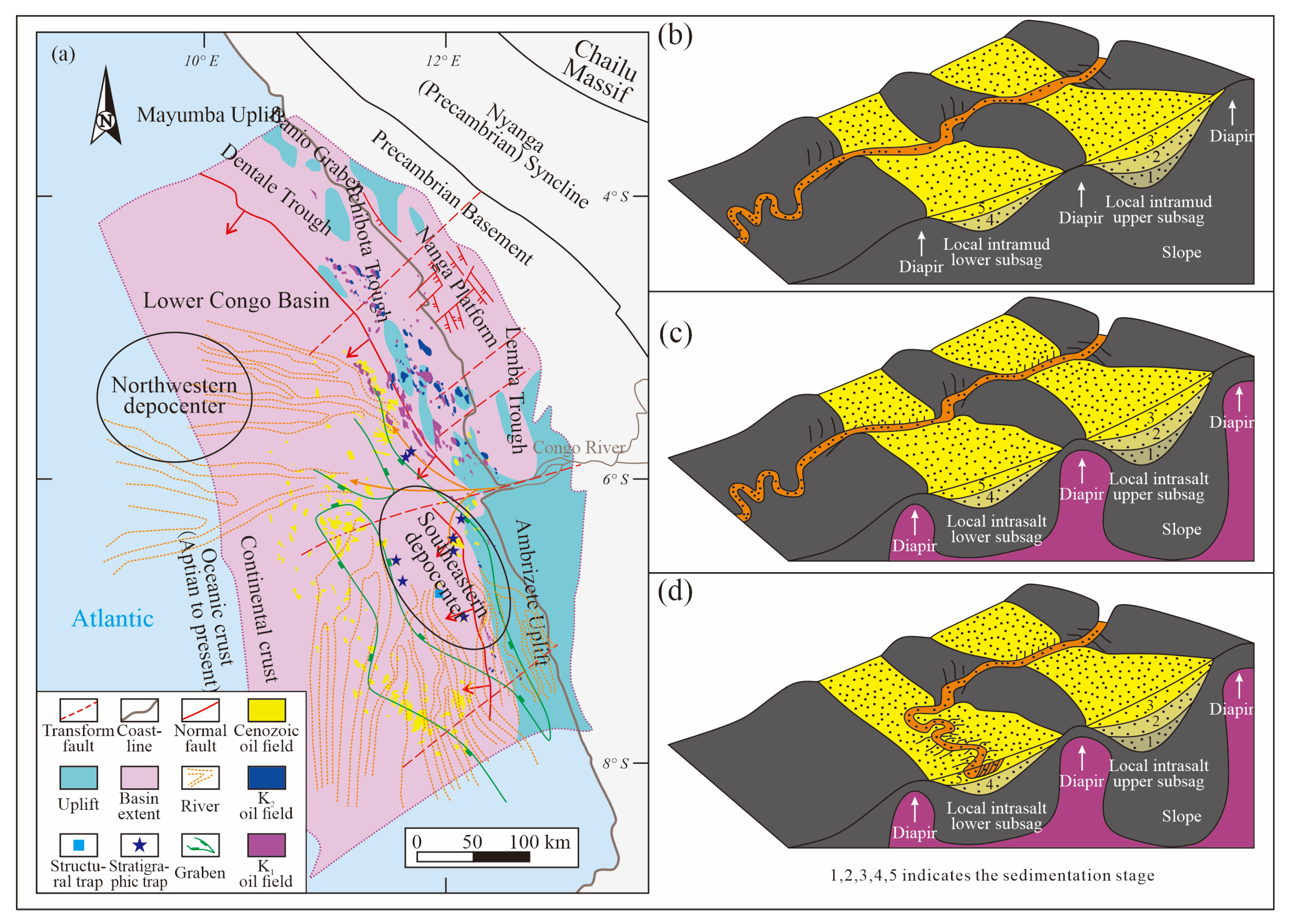
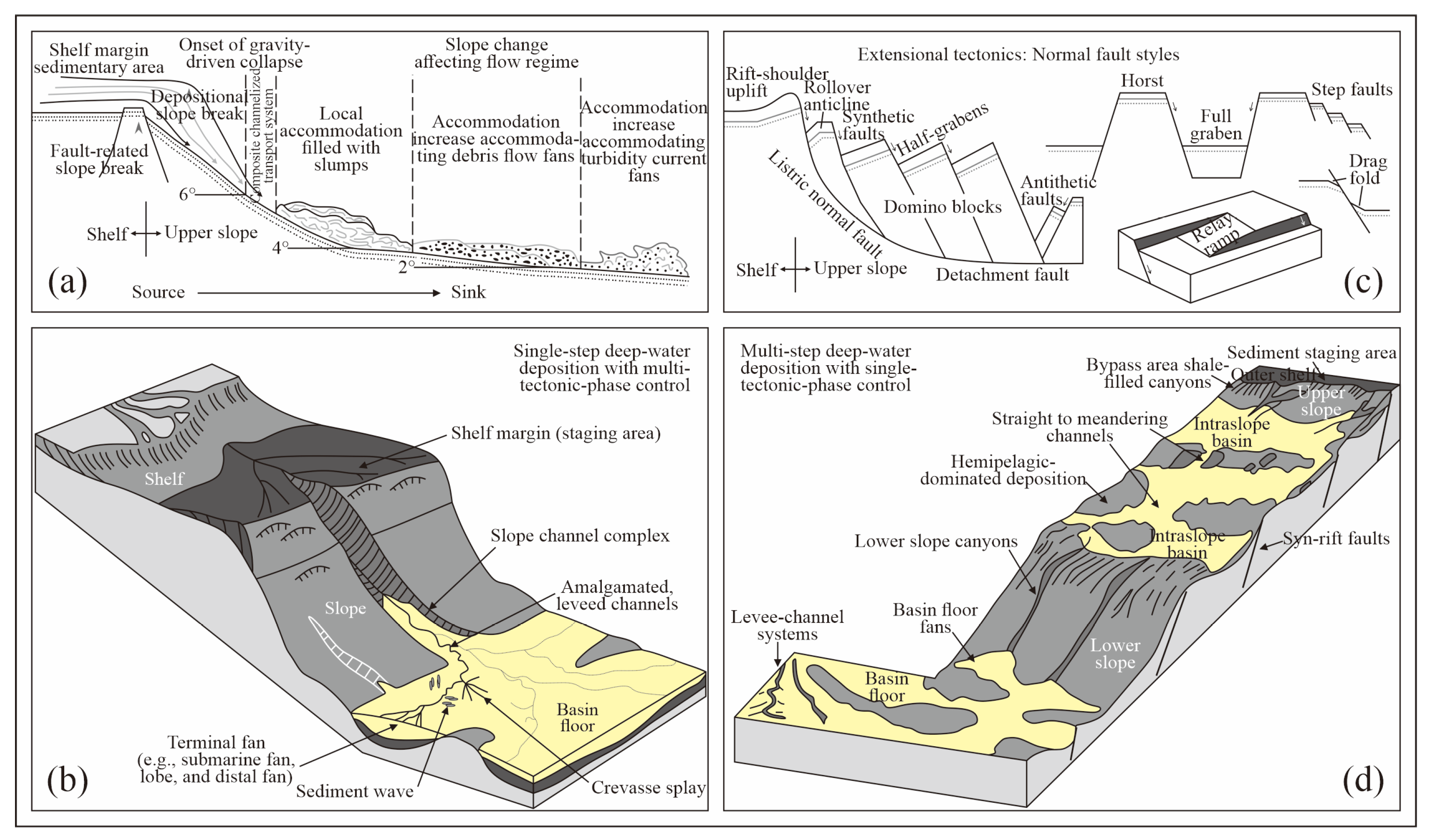
| Basin Name | Age | Structural Parameters | Morphological Parameters | |||||||
|---|---|---|---|---|---|---|---|---|---|---|
| Aa (m) | P (km) | T (My) | Ra (m/My) | Rp (km/My) | Fc (km2/My) | Ta (°) | Curvature Index | E/C Ratio | ||
| Lower Congo Basin | Quaternary | 629.0 | 15.3 | 2.5 | 251.6 | 6.1 | 3.8 | 2.4 | Upstream channels dominate, decreasing seaward | 0.2~0.6/0.5 |
| Pliocene | 750.5 | 29.3 | 2.7 | 278.0 | 10.9 | 8.2 | 1.5 | NA | NA | |
| 569.6 | −22.0 b | 5.2 | 109.5 | −4.2 | 2.4 | −1.5 | ||||
| Miocene | 515.4 | −15.7 | 17.7 | 29.1 | −0.9 | 0.5 | −1.9 | 1.1~1.5/1.2 | 0.8~1.6/1.3 | |
| 1354.9 | 54.5 | 17.7 | 76.5 | 3.1 | 4.2 | 1.4 | 1.1~1.5/1.3 | 0.2~4.2/2.8 | ||
| Oligocene | 705.3 | 28.9 | 10.8 | 65.3 | 2.7 | 1.9 | 1.4 | 1.4~1.6/1.5 | 0.5~0.6/0.6 | |
| Niger Delta Basin | Quaternary | 525.9 | 9.2 | 1.3 | 404.6 | 7.1 | 3.7 | 3.3 | 1.0~1.4/1.2 | 0.8~3.1/1.9 0.8~1.4/1.1 |
| 542.3 | 11.1 | 1.3 | 417.2 | 8.5 | 4.6 | 2.8 | 1.4~2.5/1.8 | |||
| 324.0 | 5.3 | 0.7 | 462.9 | 7.6 | 2.5 | 3.5 | 1.3~2.0/1.5 | |||
| 458.8 | 12.4 | 1.4 | 327.7 | 8.8 | 4.1 | 2.1 | NA | |||
| Pliocene | 492.9 | 4.4 | 1.2 | 410.8 | 3.7 | 1.4 | 6.3 | Co-occurrence of erosional braided channels and constructive lobe-channel complexes | ||
| 329.9 | 10.7 | 1.2 | 274.9 | 8.9 | 2.9 | 1.8 | ||||
| 661.5 | 14.8 | 1.1 | 601.4 | 13.5 | 8.9 | 2.6 | ||||
| 501.2 | 10.5 | 1.1 | 455.6 | 9.5 | 4.7 | 2.7 | ||||
Disclaimer/Publisher’s Note: The statements, opinions and data contained in all publications are solely those of the individual author(s) and contributor(s) and not of MDPI and/or the editor(s). MDPI and/or the editor(s) disclaim responsibility for any injury to people or property resulting from any ideas, methods, instructions or products referred to in the content. |
© 2025 by the authors. Licensee MDPI, Basel, Switzerland. This article is an open access article distributed under the terms and conditions of the Creative Commons Attribution (CC BY) license (https://creativecommons.org/licenses/by/4.0/).
Share and Cite
Qu, F.; Gao, X.; Gong, L.; Yin, J. Contrastive Analysis of Deep-Water Sedimentary Architectures in Central West African Passive Margin Basins During Late-Stage Continental Drift. J. Mar. Sci. Eng. 2025, 13, 1533. https://doi.org/10.3390/jmse13081533
Qu F, Gao X, Gong L, Yin J. Contrastive Analysis of Deep-Water Sedimentary Architectures in Central West African Passive Margin Basins During Late-Stage Continental Drift. Journal of Marine Science and Engineering. 2025; 13(8):1533. https://doi.org/10.3390/jmse13081533
Chicago/Turabian StyleQu, Futao, Xianzhi Gao, Lei Gong, and Jinyin Yin. 2025. "Contrastive Analysis of Deep-Water Sedimentary Architectures in Central West African Passive Margin Basins During Late-Stage Continental Drift" Journal of Marine Science and Engineering 13, no. 8: 1533. https://doi.org/10.3390/jmse13081533
APA StyleQu, F., Gao, X., Gong, L., & Yin, J. (2025). Contrastive Analysis of Deep-Water Sedimentary Architectures in Central West African Passive Margin Basins During Late-Stage Continental Drift. Journal of Marine Science and Engineering, 13(8), 1533. https://doi.org/10.3390/jmse13081533






